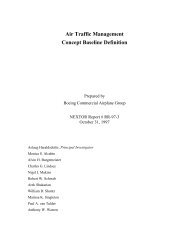Chapter 11: Weather Theory - FAA
Chapter 11: Weather Theory - FAA
Chapter 11: Weather Theory - FAA
You also want an ePaper? Increase the reach of your titles
YUMPU automatically turns print PDFs into web optimized ePapers that Google loves.
At the top of the troposphere is a boundary known as thetropopause, which traps moisture and the associated weatherin the troposphere. The altitude of the tropopause varies withlatitude and with the season of the year; therefore, it takeson an elliptical shape, as opposed to round. Location of thetropopause is important because it is commonly associatedwith the location of the jet stream and possible clear airturbulence.Above the tropopause are three more atmospheric levels. Thefirst is the stratosphere, which extends from the tropopause toa height of about 160,000 feet (50 km). Little weather existsin this layer and the air remains stable although certain typesof clouds occasionally extend in it. Above the stratosphereare the mesosphere and thermosphere which have littleinfluence over weather.Atmospheric CirculationAs noted earlier, the atmosphere is in constant motion.Certain factors combine to set the atmosphere in motion, but amajor factor is the uneven heating of the Earth’s surface. Thisheating upsets the equilibrium of the atmosphere, creatingchanges in air movement and atmospheric pressure. Themovement of air around the surface of the Earth is calledatmospheric circulation.Heating of the Earth’s surface is accomplished by severalprocesses, but in the simple convection-only model used forthis discussion, the Earth is warmed by energy radiating fromthe sun. The process causes a circular motion that resultswhen warm air rises and is replaced by cooler air.Warm air rises because heat causes air molecules to spreadapart. As the air expands, it becomes less dense and lighterthan the surrounding air. As air cools, the molecules packtogether more closely, becoming denser and heavier thanwarm air. As a result, cool, heavy air tends to sink and replacewarmer, rising air.Because the Earth has a curved surface that rotates on a tiltedaxis while orbiting the sun, the equatorial regions of the Earthreceive a greater amount of heat from the sun than the polarregions. The amount of sun that heats the Earth depends onthe time of year and the latitude of the specific region. All ofthese factors affect the length of time and the angle at whichsunlight strikes the surface.Solar heating causes higher temperatures in equatorial areaswhich causes the air to be less dense and rise. As the warmair flows toward the poles, it cools, becoming denser, andsinks back toward the surface. [Figure <strong>11</strong>-3]Figure <strong>11</strong>-3. Circulation pattern in a static environment.Atmospheric PressureThe unequal heating of the Earth’s surface not only modifiesair density and creates circulation patterns; it also causeschanges in air pressure or the force exerted by the weightof air molecules. Although air molecules are invisible, theystill have weight and take up space.Imagine a sealed column of air that has a footprint of onesquare inch and is 350 miles high. It would take 14.7 poundsof effort to lift that column. This represents the air’s weight;if the column is shortened, the pressure exerted at the bottom(and its weight) would be less.The weight of the shortened column of air at 18,000 feet isapproximately 7.4 pounds; almost 50 percent that at sea level.For instance, if a bathroom scale (calibrated for sea level)were raised to 18,000 feet, the column of air weighing 14.7pounds at sea level would be 18,000 feet shorter, and wouldweigh approximately 7.3 pounds (50 percent) less than atsea level. [Figure <strong>11</strong>-4]The actual pressure at a given place and time differs withaltitude, temperature, and density of the air. These conditionsalso affect aircraft performance, especially with regard totakeoff, rate of climb, and landings.Coriolis ForceIn general atmospheric circulation theory, areas of lowpressure exist over the equatorial regions and areas of highpressure exist over the polar regions due to a difference intemperature. The resulting low pressure allows the highpressureair at the poles to flow along the planet’s surface<strong>11</strong>-3
















